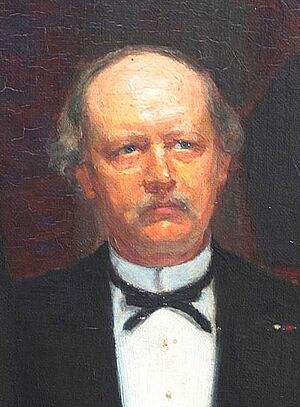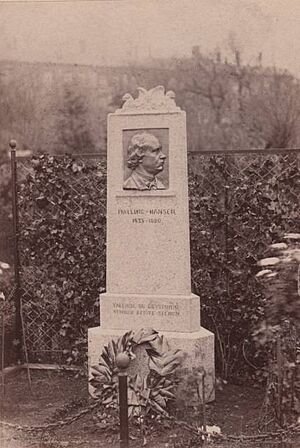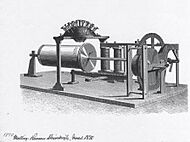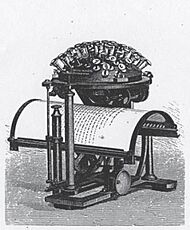Rasmus Malling-Hansen facts for kids
Quick facts for kids
Rasmus Malling-Hansen
|
|
|---|---|

Rasmus Malling-Hansen, detail from a painting by Malthe Engelsted's painting L'Hombre (1887).
|
|
| Born | 5 September 1835 |
| Died | 27 September 1890 (aged 55) |
| Nationality | Danish |
| Alma mater | University of Copenhagen |
| Known for | Hansen Writing Ball |
| Awards | Order of Vasa (1876) Order of the Dannebrog (1880) |
| Scientific career | |
| Fields | Priest, inventor, scientist, educator |
| Signature | |
Hans Rasmus Johan Malling-Hansen (born September 5, 1835 – died September 27, 1890) was a Danish inventor. He was also a minister and the principal of the Royal Institute for the Deaf. He is most famous for creating the first typewriter that was sold to many people.
Contents
Early Inventions
Malling-Hansen was born in Hunseby, Lolland, Denmark. He invented his famous machine, the Hansen Writing Ball, in 1865. This was a very early type of typewriter.
In 1874, he got a patent for a new design. This version had a flat surface for the paper instead of a round cylinder. By 1875, the writing ball changed again. It used a mechanical system to move the paper. This meant it no longer needed a battery to work.
The writing ball was sold in many European countries. However, it was quite expensive. This made it hard for many people to buy. Still, it won top awards at big exhibitions. It received first prize in Copenhagen in 1872. It also won at world exhibitions in Vienna (1873) and Paris (1878).
In 1878, Malling-Hansen also created a fast writing machine. It was called the Takygraf and was used for stenography, which is a way to write very quickly. He also discovered how useful blue carbon paper could be. He used it to create a copying method called the Xerografi. This method could make up to 100 copies of letters or drawings quickly.
Helping Deaf Students
From 1865 to 1890, Malling-Hansen was the principal of the Royal Institute for the Deaf. He felt that teaching deaf students was not working well. This was because students had very different abilities. Some were completely deaf and could not speak. Others had some hearing and could often speak.
In 1867, he suggested dividing students into three groups. Each group would be based on their abilities. He started a new method of teaching speech and lip-reading for students who had some hearing. For those who were completely deaf and had no language, the sign method was still used. This helped make sure each child got the right kind of help.
Malling-Hansen also worked to make life better for the deaf students. In those days, schools did not always understand that children needed time to play and relax. Students had to wake up at 5 AM. Besides lessons, they worked in school workshops late into the night. Many children got sick and died, often from lung diseases.
Malling-Hansen realized that the main problem was too many children in a small space. He suggested a new building with electricity. This idea was not approved by the authorities. So, he improved the outdoor garden instead. This helped reduce the number of deaths among the children.
In 1879, he proposed building a new institute in Jylland. This plan was approved. In 1881, the Royal Institute for the Deaf-mutes in Fredericia was founded. Malling-Hansen is seen as a very important person in the history of education for the deaf in Denmark and other Nordic countries. He often helped on public committees. He died at 55 years old.
Studying Children's Growth

Malling-Hansen also studied if the children at the Institute were getting enough food. He found that their growth and weight gain were good. He started a scientific study. He weighed and measured the children's height every day. To make this faster, he had special large scales made. These scales could weigh up to ten children at once.
His study showed that children do not grow at a steady rate. Instead, they grow in periods. He realized that an unknown factor affected their growth. He found the same factor when he measured trees.
He wrote to other scientists who shared their own measurement results with him. In 1886, he published a book about his studies. It was called Perioder i Børns Vækst og i Solens Varme (Periods in Children's Growth and in the Sun's Heat). In the book, he suggested that the changes in growth for children and nature were linked to changes in the sun's heat. His discoveries became known around the world. His book was even translated into German.
Family Life
Malling-Hansen married Cathrine Heiberg in 1865. She was the daughter of the previous principal of the Royal Institute. They had seven daughters. In 1876, his first wife gave birth to twin daughters. Sadly, she and the twins died. In 1880, Malling-Hansen married Anna Steenstrup, a woman he had known since he was young.
One of his daughters, Johanne Agerskov, and her husband, Michael Agerskov, wrote a book in 1920. It was a religious, ethical, and philosophical book called Toward the Light.
Awards and Recognition
- Knight of the Order of Vasa (Sweden, 1876)
- Knight of the Order of the Dannebrog (Denmark, 1880)
- Medal of Merit in Gold (Denmark, 1872)
Gallery









